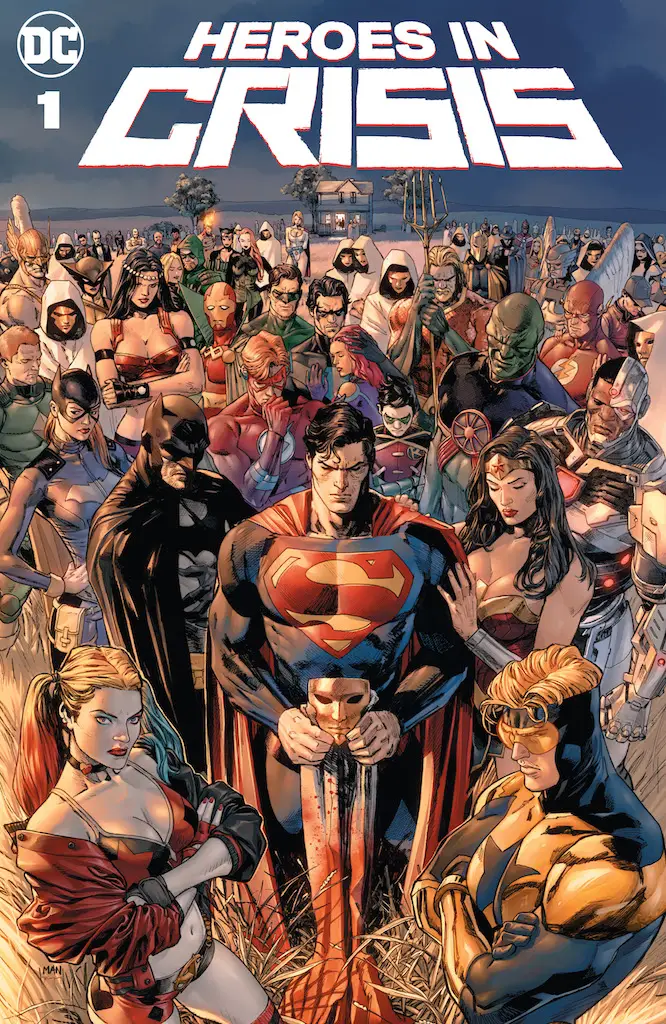Love it or hate it, Tom King’s DC superhero psychology series, Heroes in Crisis, sure is making waves. With issue #2 out tomorrow, we invited frequent AiPT! Science contributor and board-certified psychiatrist, Richard Schloss, to take a look at the events of the opener to see how well they fit with what we really know about “post traumatic stress disorder,” and how much a place like Sanctuary can really help.
During World War I it was called “Shell Shock.” In World War II it was known as “Battle Fatigue.” And by the Vietnam era it had become “Post-Traumatic Stress Disorder.” But what is it, exactly? Not all stress leads to PTSD, and PTSD is far more than just the end result of being “stressed out.”
In fact, eight distinct criteria must be met to make the diagnosis of Post-Traumatic Stress Disorder, according to the DSM-V (Diagnostic and Statistical Manual of Mental Disorders, Fifth Edition) – the closest thing psychiatry has to a “bible.” To diagnose PTSD, there must be an exposure to an actual death, or the immediate threat of death to the self or someone close by, or a similar exposure to physical or sexual violence. The traumatic event must then be persistently re-experienced, such as in flashbacks or nightmares.
The PTSD-sufferer consciously or unconsciously avoids reminders of the event or takes circuitous routes to avoid going near the scene of the event. That person feels isolated or irrationally guilty, or no longer experiences pleasure. The sufferer also experiences irritability or anger, is easily startled, and has difficulty concentrating or sleeping. The symptoms must last more than a month, must cause significant functional impairment, and must not be due to some other psychiatric illness or to substance abuse.

Image credit: DC Comics
PTSD may be acute or chronic. Those with acute PTSD generally had supportive environments while growing up and can employ effective coping mechanisms that enable them to spontaneously recover. Chronic PTSD sufferers, by contrast, often had chaotic home environments during their youth, and overuse primitive psychological defenses to avoid feeling constantly overwhelmed.
It’s easy to see why combat veterans or first responders would be prime candidates for developing PTSD. So would rape victims, sufferers of systematic physical or emotional abuse over time, and survivors of natural disasters or severe motor vehicle crashes. And then there’s the case of a person who witnesses the death of close relatives, such as his or her parents (Bruce Wayne, anyone?).
In fact, it’s no stretch to point out that many if not most comic book superheroes should already have PTSD in one form or another. Superman’s home world was destroyed. Spider-Man’s parents were killed in a plane crash. The first Green Lantern, Alan Scott, was the sole survivor of a railroad bridge collapse. And so on.
Comic book heroes generally emerge after overcoming tragedy and loss. There’s the desire to set things right in the universe — to protect those weaker than they from succumbing to the same dark forces that almost vanquished them. But while they defeat the demons without, are they also fighting the demons within?

Image credit: DC Comics
In last month’s Heroes in Crisis #1, by former CIA counterterrorism officer, Tom King, Booster Gold (apparently) snaps and goes on a murderous rampage — and then forgets he did so. Contrary to popular belief, though, the link between PTSD and violent behavior is unclear.
A 2012 article in the Washington Post reported, “Veterans with PTSD are two to three times as likely to be physically abusive of their wives and girlfriends as those without the diagnosis. They’re three times as likely to get into fistfights when they go to college. One study showed they are especially prone to ‘impulsive aggression.'”
Yet so-called “premeditated aggression” — such as getting a gun and going to a specific place to shoot at people — was actually more common among veterans without PTSD. Violent outbursts and poor impulse control may be more prevalent among persons with traumatic brain injury (TBI) than among those with PTSD alone, who tend to be hypervigilant and avoidant rather than aggressive and confrontational.
So it seems reasonable to say that, while PTSD sufferers may occasionally become violent, most violent acts are committed by people who do not suffer from PTSD. And, while untreated chronic PTSD tends to worsen over time, it does respond quite well to appropriate treatment.
Join the AIPT Patreon
Want to take our relationship to the next level? Become a patron today to gain access to exclusive perks, such as:
- ❌ Remove all ads on the website
- 💬 Join our Discord community, where we chat about the latest news and releases from everything we cover on AIPT
- 📗 Access to our monthly book club
- 📦 Get a physical trade paperback shipped to you every month
- 💥 And more!













You must be logged in to post a comment.